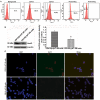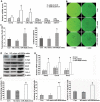Ascl2 knockdown results in tumor growth arrest by miRNA-302b-related inhibition of colon cancer progenitor cells
- PMID: 22384170
- PMCID: PMC3285660
- DOI: 10.1371/journal.pone.0032170
Ascl2 knockdown results in tumor growth arrest by miRNA-302b-related inhibition of colon cancer progenitor cells
Abstract
Background: Achaete scute-like 2 (Ascl2), a basic helix-loop-helix (bHLH) transcription factor, controls the fate of intestinal stem cells. However, the role of Ascl2 in colon cancer progenitor cells remains unknown. The cell line HT-29 (47.5-95% of CD133(+) population) and LS174T (0.45% of CD133(+) population) were chosen for functional evaluation of Ascl2 in colon cancer progenitor cells after gene knockdown by RNA interference.
Methodology/principal findings: Immunohistochemistry demonstrated that Ascl2 was significantly increased in colorectal adenocarcinomas. Downregulation of Ascl2 using RNA interference in cultured colonic adenocarcinoma HT-29 and LS174T cells reduced cellular proliferation, colony-forming ability, invasion and migration in vitro, and resulted in the growth arrest of tumor xenografts in vivo. The Ascl2 protein level in CD133(+) HT-29 cells was significantly higher than in CD133(-) HT-29 cells. Ascl2 blockade via shRNA interference in HT-29 cells (shRNA-Ascl2/HT-29 cells) resulted in 26.2% of cells staining CD133(+) compared with 54.7% in control shRNA-Ctr/HT-29 cells. The levels of 'stemness' associated genes, such as CD133, Sox2, Oct4, Lgr5, Bmi1, and C-myc, were significantly decreased in shRNA-Ascl2/HT-29 and shRNA-Ascl2/LS174T cells in vitro as well as in the corresponding tumor xenograft (CD133 was not performed in shRNA-Ascl2/LS174T cells). The shRNA-Ascl2/HT-29 cells had inhibited abilities to form tumorspheres compared with control. The microRNA (miRNAs) microarrays, identified 26 up-regulated miRNAs and 58 down-regulated miRNAs in shRNA-Ascl2/HT-29 cells. Expression levels of let-7b, miRNA-124, miRNA-125b, miRNA-17, miRNA-20a and miRNA-302b, involved in the regulation of 'stemness', were quantified with qPCR, which confirmed their identities. Restoration of miRNA-302b, via its mimic, led to the restoration of shRNA-Ascl2/HT-29 'stemness' characteristics, including tumorsphere formation and 'stemness' associated genes levels, and the recovery of cellular behaviors, including colony-forming ability, invasion and migration in vitro.
Conclusions/significance: Ascl2 may be a potential target for the inhibition of colon cancer progenitor cells, and functions through a miR-302b-related mechanism.
Conflict of interest statement
Figures








Similar articles
-
R-spondin1/Wnt-enhanced Ascl2 autoregulation controls the self-renewal of colorectal cancer progenitor cells.Cell Cycle. 2018;17(8):1014-1025. doi: 10.1080/15384101.2018.1469874. Epub 2018 Jun 25. Cell Cycle. 2018. PMID: 29886802 Free PMC article.
-
MicroRNA-200 (miR-200) cluster regulation by achaete scute-like 2 (Ascl2): impact on the epithelial-mesenchymal transition in colon cancer cells.J Biol Chem. 2014 Dec 26;289(52):36101-15. doi: 10.1074/jbc.M114.598383. Epub 2014 Nov 4. J Biol Chem. 2014. PMID: 25371200 Free PMC article.
-
Ascl2 activation by YAP1/KLF5 ensures the self-renewability of colon cancer progenitor cells.Oncotarget. 2017 Nov 27;8(65):109301-109318. doi: 10.18632/oncotarget.22673. eCollection 2017 Dec 12. Oncotarget. 2017. PMID: 29312609 Free PMC article.
-
Loss of ATOH8 Increases Stem Cell Features of Hepatocellular Carcinoma Cells.Gastroenterology. 2015 Oct;149(4):1068-81.e5. doi: 10.1053/j.gastro.2015.06.010. Epub 2015 Jun 20. Gastroenterology. 2015. PMID: 26099525
-
Achaete scute-like 2 suppresses CDX2 expression and inhibits intestinal neoplastic epithelial cell differentiation.Oncotarget. 2015 Oct 13;6(31):30993-1006. doi: 10.18632/oncotarget.5206. Oncotarget. 2015. PMID: 26307678 Free PMC article.
Cited by
-
Study of apoptosis-related interactions in colorectal cancer.Tumour Biol. 2016 Nov;37(11):14415-14425. doi: 10.1007/s13277-016-5363-9. Epub 2016 Sep 15. Tumour Biol. 2016. PMID: 27629291 Review.
-
The integrative knowledge base for miRNA-mRNA expression in colorectal cancer.Sci Rep. 2019 Dec 2;9(1):18065. doi: 10.1038/s41598-019-54358-w. Sci Rep. 2019. PMID: 31792281 Free PMC article.
-
ASCL2 expression contributes to gastric tumor migration and invasion by downregulating miR223 and inducing EMT.Mol Med Rep. 2018 Oct;18(4):3751-3759. doi: 10.3892/mmr.2018.9363. Epub 2018 Aug 8. Mol Med Rep. 2018. PMID: 30106147 Free PMC article.
-
Inferring regulators of cell identity in the human adult pancreas.NAR Genom Bioinform. 2023 Jul 10;5(3):lqad068. doi: 10.1093/nargab/lqad068. eCollection 2023 Sep. NAR Genom Bioinform. 2023. PMID: 37435358 Free PMC article.
-
DPEP1 promotes drug resistance in colon cancer cells by forming a positive feedback loop with ASCL2.Cancer Med. 2023 Jan;12(1):412-424. doi: 10.1002/cam4.4926. Epub 2022 Jun 6. Cancer Med. 2023. PMID: 35670012 Free PMC article.
References
-
- Jemal A, Siegel R, Ward E, Hao Y, Xu J, et al. Cancer statistics, 2009. CA Cancer J Clin. 2009;59:225–249. - PubMed
-
- Tan BT, Park CY, Ailles LE, Weissman IL. The cancer stem cell hypothesis: a work in progress. Lab Invest. 2006;86:1203–1207. - PubMed
-
- O'Brien CA, Pollett A, Gallinger S, Dick JE. A human colon cancer cell capable of initiating tumour growth in immunodeficient mice. Nature. 2007;445:106–110. - PubMed
-
- Ricci-Vitiani L, Lombardi DG, Pilozzi E, Biffoni M, Todaro M, et al. Identification and expansion of human colon-cancer-initiating cells. Nature. 2007;445:111–115. - PubMed
Publication types
MeSH terms
Substances
LinkOut - more resources
Full Text Sources
Other Literature Sources
Molecular Biology Databases
Research Materials

